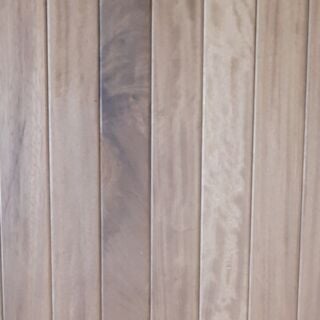Hardwood Timbers
American Poplar (Tulip wood)
Main Uses for Poplar
Light construction, furniture, kitchen cabinets, doors, panelling, moulding and millwork, edge-glued panels, turnings, and carvings.
Appearance
The sapwood is creamy white and may be streaked, and the heartwood varies from pale yellowish-brown to olive green. The green colour in the heartwood will tend to darken on exposure to light and turn brown. The wood has a medium-to-fine texture and is straight-grained.
Grain/Texture of Poplar Hardwood
Poplar typically has a straight, uniform grain, with a medium texture. Low natural luster.
Working Properties
Poplar hardwood timber is a versatile wood that is easy to machine, plane, turn, glue, and bore. It dries easily with minimal movement in performance and has little tendency to split when nailed. It takes and holds paint, enamel, and stain exceptionally well. Poplar is very easy to work in almost all regards, one of Poplar’s only downsides is its softness. Due to its low density, Poplar can sometimes leave fuzzy surfaces and edges: especially during shaping or sanding. Sanding to finer grits of sandpaper may be necessary to obtain a smooth surface.
Physical Properties of Poplar
Poplar is a medium-density wood with low-bending, shock resistance, stiffness, and compression values.
Odour
Poplar Hardwood Timber has no characteristic odour
Rot Resistance of Poplar Hardwood
Heartwood is rated as being moderately durable to non-durable, susceptible to insect attack.
American Ash Hardwood Timber
Main Uses of Ash Hardwood Timber
Furniture, flooring, doors, architectural millwork and moulding, kitchen cabinets, panelling, tool handles, sporting equipment, stair parts and turnings.
Appearance
The sapwood is light-coloured to nearly white and the heartwood varies from greyish or light brown, to pale yellow streaked with brown. The wood is generally straight-grained with a uniform texture. Properties will vary according to the growing regions.
Grain/Texture of Ash Hardwood
Ash hardwood timber has a medium to coarse texture similar to oak. The grain is almost always straight & regular, though sometimes moderately curly or figured boards can be found.
Working properties
Ash machines well, is good in nailing, screwing and gluing, can be stained to a very good finish. It dries fairly easily with minimal degrade, and there is little movement in performance.
Physical Properties
Ash hardwood timber has very good overall strength properties relative to its weight and has excellent shock resistance (Hurleys as an example…Although usually made from Irish ash)
Odour
American Ash has a distinct and moderately unpleasant odour when being worked.
Rot Resistance of American Ash Hardwood
Heartwood is rated as perishable or only slightly durable in regards to decay. Ash is also not resistant to insect attack.
American Walnut
Main Uses
Walnut hardwood timber is used for furniture, cabinets, architectural millwork, doors, flooring, panelling, stair parts. Very good for use in contrast work with lighter-coloured species.
Appearance
The sapwood is creamy white, while the heartwood is light brown to dark chocolate brown, occasionally with a purplish cast and darker streaks. The wood is generally straight-grained; sometimes with wavy or curly grain that is both attractive and decorative.
Grain/Texture of Walnut Hardwood
Walnut Hardwood Timber grain is usually straight but can be irregular. Has a medium texture & moderate natural luster.
Working Properties of Walnut Hardwood
Nails, screws, and glues well, holds paint and stain very well for an exceptional finish and is readily polished. It dries slowly, Has good stability. Typically, easy to work with.
Physical Properties of Walnut Hardwood Timber
Walnut hardwood timber is a tough hardwood of medium density, with moderate bending and crushing strengths, and low stiffness.
Odour
Walnut hardwood timber has a faint, mild odour when being worked.
Rot Resistance of Walnut Hardwood
Walnut is rated as very durable in terms of decay resistance, though it is susceptible to insect attack.
American White Oak
Main Uses
American white oak hardwood timber is used for furniture, flooring, architectural millwork, moulding, doors, kitchen cabinets, panelling, Stair parts.
Appearance
The sapwood is light-coloured and the heartwood is light-to-dark brown. White oak is mostly straight-grained with a medium-to-coarse texture.
Grain/Texture of White Oak Hardwood Timber
White Oak Hardwood timber has a straight grain, with coarse, uneven texture
Working Properties of White Oak Hardwood Timber
White Oak Hardwood machines well, nails and screws well. Due to its reaction with iron, galvanized nails are recommended. Its adhesive properties are variable. The wood dries slowly, but stains to a good finish. Has a moderately high shrinkage values, resulting in mediocre dimensional stability, especially in flatsawn boards. Can react with iron (particularly when wet) and cause staining & discolouration.
Physical Properties of White Oak Hardwood Timber
White oak is a hard and heavy wood with a medium-bending and crushing strength, it has great wear-resistance.
Odour
Has a tell-tale smell that is common to most oaks. Most find it appealing.
Rot Resistance of White Oak Hardwood
Rated as very durable
Iroko Hardwood Timber
Main Uses
interior and exterior joinery…Windows, Doors, Stairs, Furniture etc.
Appearance
Heartwood is usually a yellow o golden or medium brown, with colour tending to darken over time. Pale yellow sapwood is clearly demarcated from the heartwood.
Grain/Texture of Iroko Hardwood Timber
Iroko has a medium to coarse texture, with open pores and an interlocked grain.
Working properties of Iroko Hardwood Timber
Medium to difficult. Generally easy to work, with exception of its interlocked grain, which may cause tearout during surfacing operations. Deposits of calcium carbonate are sometimes present, which can have a significant dulling effect on cutters. Iroko glues & finished well. Very durable
Odour
Iroko hardwood timber has no characteristic odour.
Rot Resistance
Iroko is very durable, and is resistant to both rot and insect attack. Iroko is sometimes used as a substitute for Teak.
Sapele Hardwood timber
Main Uses
Interior and exterior joinery, furniture, flooring, veneer
Appearance
Heartwood tends to be a golden to dark reddish brown colour. Colour tend to darken with age. Besides the common ribbon pattern seen on quarter sawn boards, Sapele is known for a wide variety of other figured grain patterns such as pommele, quilted, mottled, wavy , beeswing and fiddleback.
Grain/Texture of Sapele Hardwood Timber
Grain is interlocked and sometimes wavy. Fine uniform texture and good natural luster.
Working properties of Sapele Hardwood Timber
Medium – Sapele can be troublesome to work in some machining operations (planning, routing etc.) resulting in tear out due to its interlocked grain. It will also react when put into direct contact with iron, becoming discoloured and stained. Sapele has a slight blunting effect on cutters but it turns, glues and finished well. Sapele is moderately durable.
Odour
Sapele hardwood timber has a distinct, cedar-like scent while being worked.
Rot Resistance of Sapele Hardwood
Heartwood ranges from moderately durable to very durable in regards to decay resistance. Moderate insect resistance.



